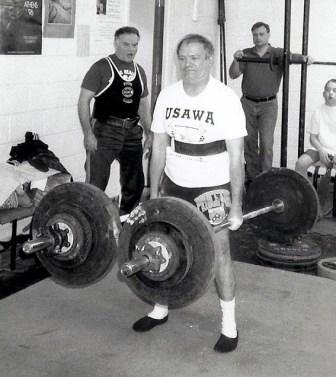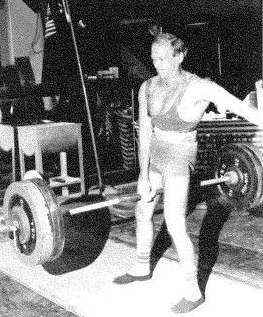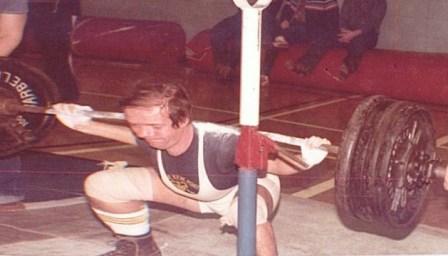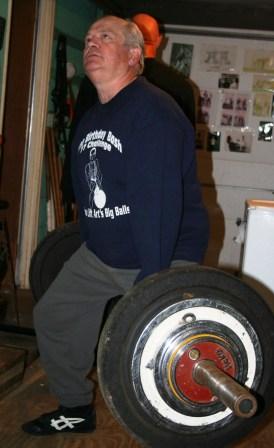OLD ADAGES, NEW ADAGES
BY DAVE GLASGOW
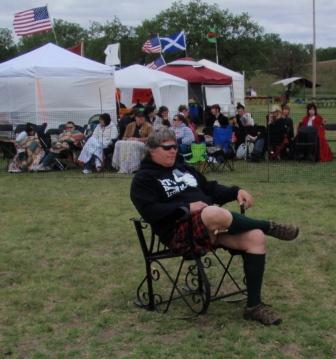
Dave Glasgow now knows when to "take a break" from heavy training and enjoy a little relaxation in his rocking chair (photo contributed by the webmaster, which was taken a few weeks ago when Dave very successfully promoted a big Highland Games in Wichita, Kansas).
THERE IS AN ADAGE STATING, ‘IF ONE’S GOOD, TWO’S BETTER AND THREE’S JUST ENOUGH!” HOWEVER, IN TRAINING, THIS SAYING COULD NOT BE FARTHER FROM THE TRUTH!! LET ME EXPLAIN.
FOLKS WHO TRAIN WITH WEIGHTS ARE, FOR THE MOST PART, SELF-DRIVEN, HIGHLY MOTIVATED INDIVIDUALS. THEY SEE A MEANS TO THE GOAL THEY HAVE SET AND THEY “GET AFTER IT.” HOWEVER, IN MANY, MANY CASES, THIS ENTHUSIASM IS MISDIRECTED.
I WILL USE MY OWN EXPERIENCE AS AN EXAMPLE. WHEN I WAS JUST OUT OF COLLEGE, I BEGAN TRAINING ON MY OWN. ALL I KNEW WAS THE SPARSE, AND OFTEN MISLEADING, INFORMATION GLEANED FROM THE BODYBUILDING MAGAZINES OF THE TIME. I TOTALLY IGNORED, AS A WHOLE, THE INFO GIVEN BY PEARY RADAR IN THE NOW DEFUNCT, BUT NONE THE LESS VERY EXCELLENT ‘IRONMAN’.
BEING THAT ABOVE MENTIONED ‘ENTHUSIASTIC’ LIFTER, I WORKED THE SAME LIFTS TWICE A WEEK. BENCH, SQUAT, DEADLIFT. FIVE SETS OF FIVE. THOSE WERE MY ‘WORKING’ SETS!! SAME WEIGHT FOR EACH SET. SET AFTER SET, REP AFTER REP. I WORKED HARD BUT COULD NOT UNDERSTAND WHY I WAS MAKING VERY LITTLE PROGRESS! “IF ONE IS GOOD THEN TWO IS BETTER AND THREE JUST ENOUGH. WELL, THEN, BY GOD, FOUR TIMES A WEEK IS PERFECT!”. I THOUGHT!! WHEN WAS I TO RECOVER WITH THAT REGIME?? THE ANSWER? NEVER!! I HAD NO REAL RECOVERY TIME, AT ALL.
THERE ARE SO MANY FACTORS INVOLVED IN RECOVERY. AGE; WHAT ONE DOES FOR A LIVING; NUTRITION…. IT GOES ON AND ON. I FOUND THAT A GOOD NIGHTS SLEEP AND A COUPLE OF BEERS DID NOT CONSTITUTE RECOVERY.
WHEN WE WERE LIFTING IN COLLEGE, WE WOULD GO BALLS OUT FOR SIX WEEKS OR SO, THEN HAVE TO LAY OUT FOR A WEEK OR 10 DAYS FOR WHATEVER REASON. THEN WE WOULD COME BACK AND OUR LIFTS HAD ACTUALLY IMPROVED!! WHAT THE …???? SIMPLE. THE BODY HAD HAD TIME TO REBUILD AND ADAPT. WE WERE JUST TOO NAÏVE, AT THAT TIME, TO UNDERSTAND THE PHYSIOLOGY INVOLVED.
NOW, BEING MUCH OLDER AND WISER (!!??), I HAVE COME TO REALIZE THAT MOST TIMES A NEW ADAGE THAT HAS SPRUNG UP RECENTLY IS THE COURSE ONE SHOULD TAKE. LESS IS MORE!! WHEN YOU HAVE TO DRAG YOUR BUTT INTO A WORKOUT, CHANCES ARE YOU ARE JUST DEFEATING YOUR OBJECTIVE FROM THE GET GO. IN MY OPINION, YOU MIGHT BE BETTER OFF USING THAT HOUR OR SO THAT YOU WORKOUT TO TAKE A NAP. THAT, MY FRIENDS, MAY, INDEED, BE TIME WELL SPENT.
TRUTH IS, WHAT IS GOOD FOR LIFTER ‘A’, MAY NOT NECESSARILY, BE GOOD FOR LIFTER ‘B’. WE EACH HAVE TO FIND WHAT IS BEST FOR US AS INDIVIDUALS AND SEEK OUT OUR OWN LEVEL. THIS CAN ONLY BE ACCOMPLISHED BY A CONSTANT ‘TWEAKING’ OF OUR TRAINING, ESPECIALLY AS WE GET OLDER, TO GET MAXIMUM RESULTS FROM OUR EFFORTS. THIS TAKES TIME AND EFFORT; HOWEVER, I FEEL IT IS TIME WELL SPENT. NEVER FORGET!! TIME TAKES TIME!!
TRAIN HARD, SMART AND RECOVER. YOUR BODY WILL LOVE YOU FOR IT!!
###(AS A SIDE NOTE, I WOULD ENCOURAGE EVERY LIFTER TO READ WENDLER’S “5/3/1” PROGRAM. I FEEL HE MAKES SOME VERY VALID POINTS AND I HAVE HAD GOOD LUCK WITH THIS SCHEDULE. IT ALSO FITS IN PERFECTLY WITH MY THROWING AGENDA.)###
